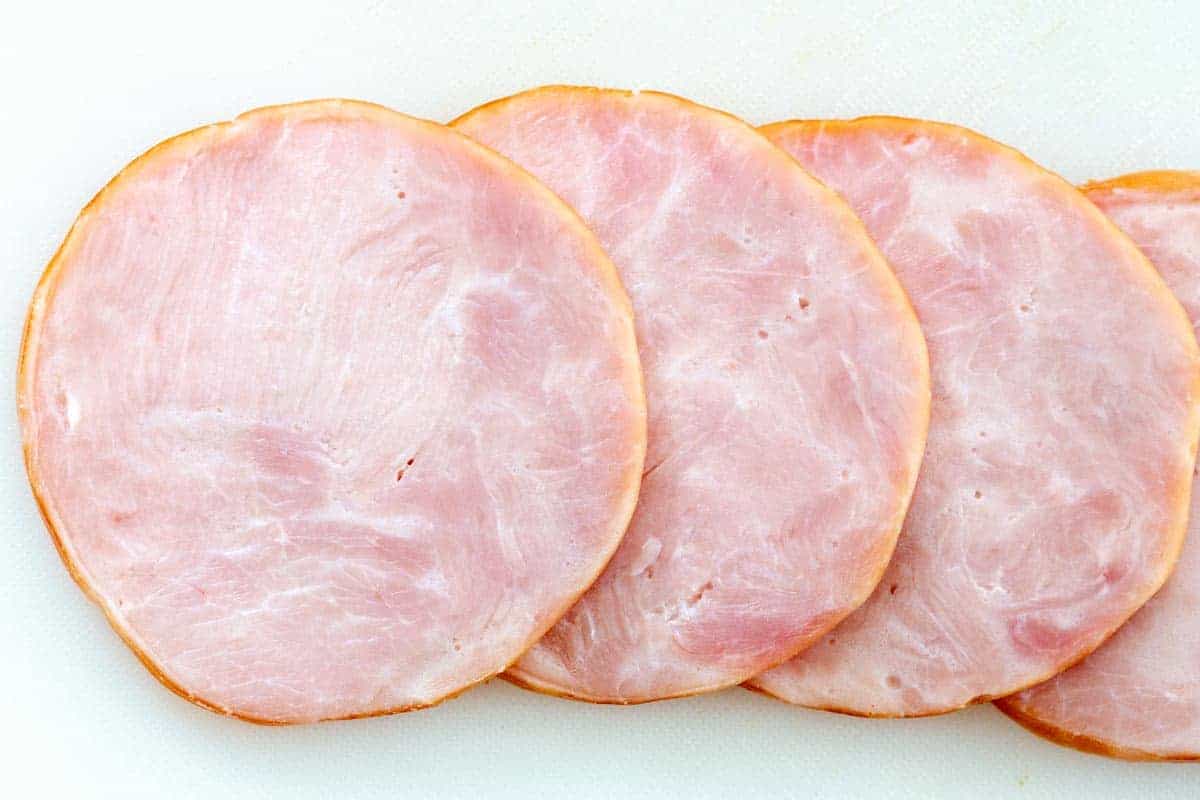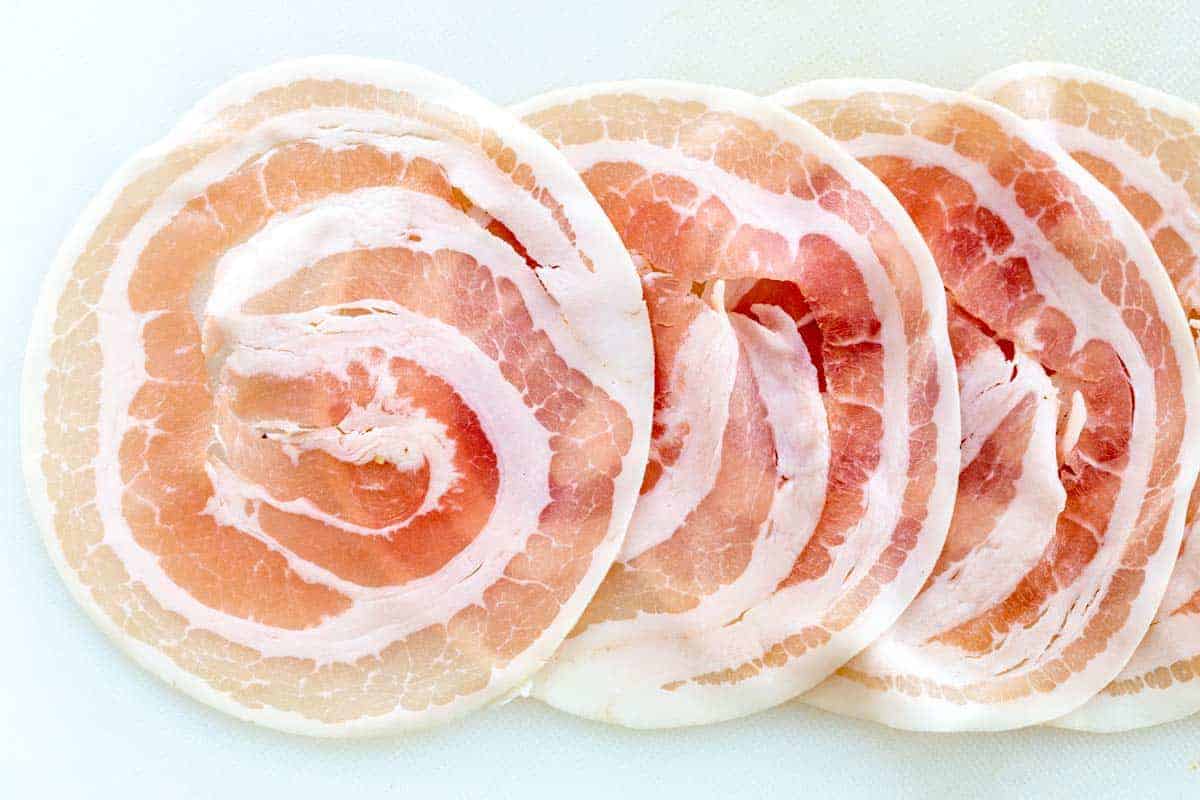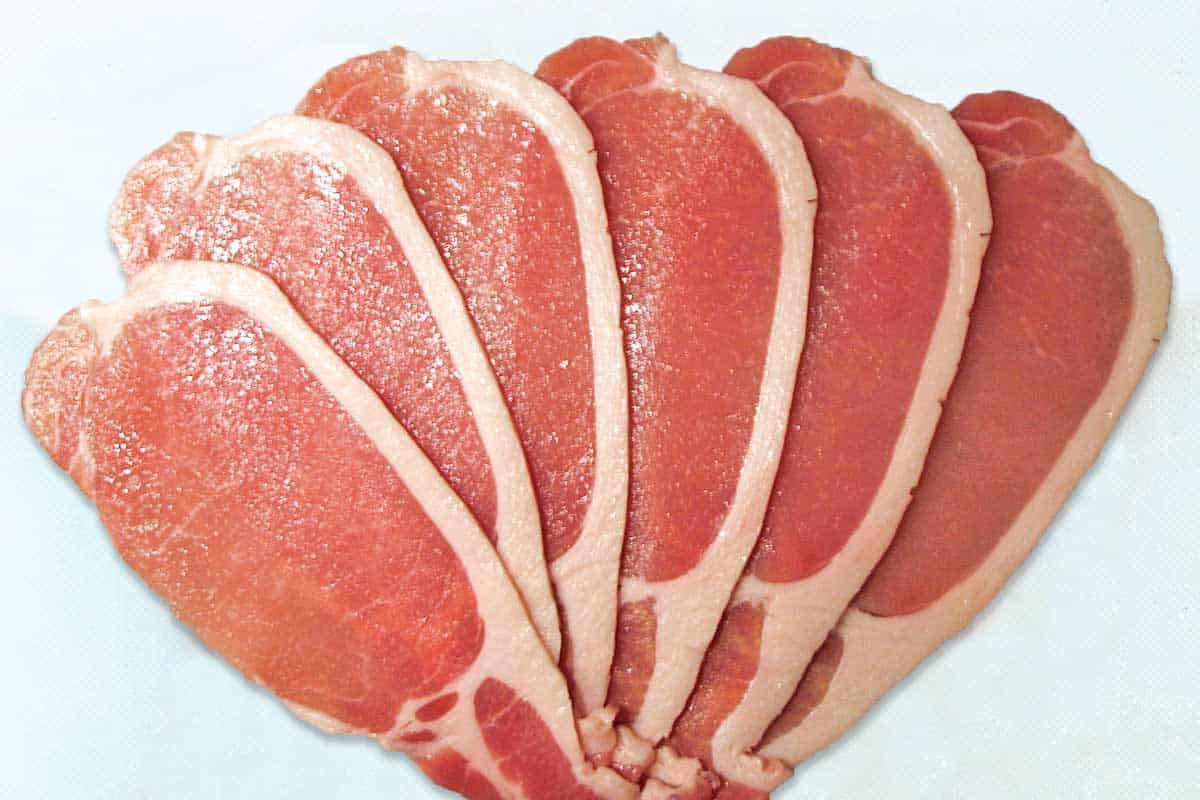Bacon makes the world go ’round. OK, not really, but it definitely makes our mouths water. Let’s learn more about the different types of bacon and how to use it for recipe magic.

Table of Contents
- American-style bacon
- Slab bacon
- Canadian bacon
- Pancetta
- Guanciale
- Rashers
- Irish bacon
- Gypsy bacon
- Turkey bacon
- What can you do with bacon fat?
- American bacon thickness types
- What’s the difference between center-cut and regular bacon?
- Uncured versus cured bacon
- Why are nitrites and nitrates added to bacon?
- Cooking with bacon
Savory pieces of bacon are a beloved food for breakfast, lunch, and dinner. Why not get to know it better? Around the world, there are different types and ways to use them in recipes. Learn about the cuts of pork used for each style, and try some new varieties in your next meal. This guide will expand your bacon repertoire!
What’s great about bacon is that it can stand up to sweet and savory dishes. Hence, we eat bacon with our pancakes drenched in maple syrup and use it to wrap chicken. Whether it be slices cooked until crispy to complete a meal or as an ingredient to enhance pasta dishes, salads, soups, and sandwiches. It’s versatile and adds a ton of undeniable flavor.
American-style bacon

If someone asked you what a traditional American breakfast was, this is the bacon you’d picture next to a short stack of pancakes or a few eggs. It’s also referred to as streaky bacon or side bacon.
The long, narrow strips of fatty, smoked pork belly make it easy to cook on the stovetop or roasted in the oven until crispy or chewy, depending on your preference. It comes from the pork belly and produces a lot of rich greases that can be used as a flavorful fat for cooking and baking.
Slab bacon

If you already cook with bacon and use it in various ways, you might try purchasing slab bacon. That’s right. You can buy an actual slab of bacon; you just may have to go to a farmer’s market or local butcher to get it.
Essentially, it’s just American-style bacon before it’s sliced. Purchasing it this way allows you to control how thick or thin to cut the bacon based on what you’re cooking. It’s great to cut into chunky lardons for soups, stews, and beef bourguignon.
Canadian bacon

Unlike American-style bacon, Canadian bacon is made from pork loin. It has less marbling and, therefore, won’t render as much fat and grease, but it is a tasty addition to Denver omelets, ham and cheese quiche, and other breakfast dishes like eggs benedict. It’s also the co-star of sweet and savory slices of Hawaiian pizza. You’ll notice that it’s sold in thicker round slices rather than long strips.
Pancetta

Like American-style bacon, pancetta is an Italian cured pork belly. However, pancetta is not cured and smoked (Amerian-style bacon is). It’s usually sold in small, prechopped cubes. Often used to make pasta carbonara.
You can also find it at the deli counter, where the butcher can produce thin slices. This is ideal if you plan to wrap it around other meat or vegetables before cooking, like bacon wrapped shrimp or bacon wrapped asparagus.
Guanciale
Italian cured bacon made from pig cheeks. It has a vibrant and savory flavor due to its high-fat content. It’s seasoned with salt and herbs like black pepper, rosemary, spicy red pepper, or garlic. It’s aged for about 3 months, resulting in a very salty flavor similar to pancetta or American bacon.
The meat is soft and buttery in texture. It’s harder to find sources in the United States due to import restrictions from Italy. It can be sliced and baked, sauteed with bitter greens like kale or beans, or pan-fried to add richness to pasta like carbonara and amatriciana.
Rashers

Also referred to as British bacon or back bacon, it differs from American-style bacon in a few ways. It’s not smoked like American bacon often and comes from the loin instead of the belly (like Canadian bacon). However, it has a little more fat than Canadian bacon. Serve buttery toast, eggs, grilled mushrooms, or beans.
Irish bacon
Irish bacon is similar to British bacon (aka rashers) but slightly less fatty and leaner. It’s cured and cuts into rounds, like a thick slice of pork loin. It’s delicious to cook for breakfast with fried eggs or for lunch with homemade mashed potatoes or rice.
Gypsy bacon
A type of smoke-cured bacon that still has the rind. It’s popular meat to purchase in German or Hungarian stores. It’s typically cooked over an open flame to release the flavor of the meat and fat beneath the rind. It’s seasoned with paprika and garlic and great to enjoy at a campfire. Served with fresh vegetables, rye bread, or add to soups and stews.
Turkey bacon
For those looking for a lower-in-fat pork bacon alternative, grab a package of turkey bacon. The poultry meat is seasoned, chopped, shaped into strips, and often smoked set proteins for a sliceable texture and smokey flavor. It’s highly processed, so check the labels for sodium levels. If you can find it, duck bacon is a variety to try.
What can you do with bacon fat?
The possibilities are nearly endless. For anything that calls for butter or oil, use bacon fat. You can fry, saute, or simmer whatever you’re cooking. Its smoke point is around 370ºF (188ºC), so don’t heat it too high. It goes great with Brussels sprouts; I’ve used it to make risotto dishes.
If you don’t use it right away, you can reserve it for later. You can use it instead of butter when eating corn on the cob, melt it over your reverse sear steak, and cook your scrambled eggs in it. Some people even bake with it (for example, instead of lard in pie crust, use solidified bacon fat).
American bacon thickness types

- Standard-cut bacon (also called regular, classic, or average) is about 1/16-inch thick. This gives the light and crispy pieces.
- Thick-cut bacon is about double the standard thickness, around 1/8-inch thick.
- Extra thick-cut bacon is about 1/4-inch thick. These give a chewier, more hearty texture.
Alternatively, Restaurant bacon is about 1/32-inch thick. This cooks up very quickly to super thin and crispy strips—ideal for serving in fast-paced restaurants, hotels, and diners. The thickness of the different bacon cuts varies by brand.
What’s the difference between center-cut and regular bacon?
Center-cut bacon contains about 25 to 30% less fat than uncooked, standard-cut bacon. The fatty ends of the bacon strips are trimmed off, leaving you with shorter strips. When cooked, the taste is similar to regular bacon. You are paying a comparable price for less fat.
Uncured versus cured bacon
Bacon is cured in salt and/or artificial sodium nitrates to add flavor and prevent odors and bacteria. But when the label reads “no added nitrates,” this can be considered uncured bacon. However, that doesn’t necessarily mean it’s nitrate-free. It was likely cured using a smoking process and the naturally occurring nitrates in celery powder and other seasonings.
Why are nitrites and nitrates added to bacon?
Sodium nitrite (with an “i”) and sodium nitrate (with an “a”) are salts often added to cured meats. Sodium nitrite also acts as an antioxidant. Both are food preservatives that help extend the shelf life of meat, reduce bacteria and toxins like botulism, and add a pink or red color to the meat.
Uncured bacon without the added preservatives is readily available in the market. However, they tend to have a shorter shelf life and must remain refrigerated.





Lila says
Thank you for your lessons about bacon types, sizes and uses. I just stumbled upon the blog and it’s so helpful!
Jessica Gavin says
I’m so glad you found me Lila! Thrilled to hear you find the blog helpful in your cooking journey.